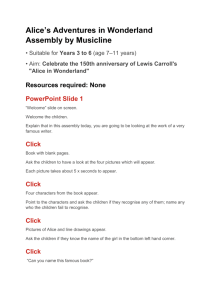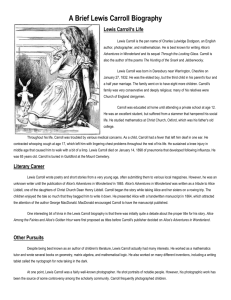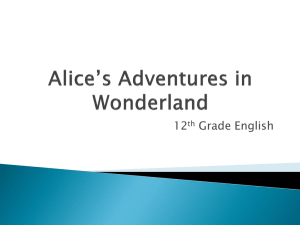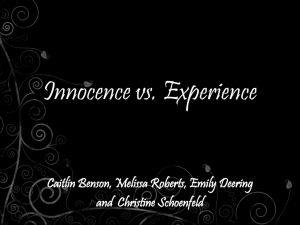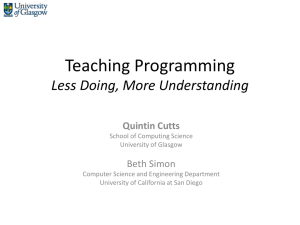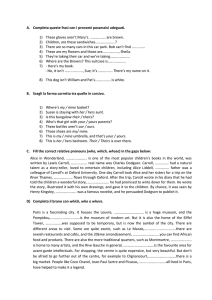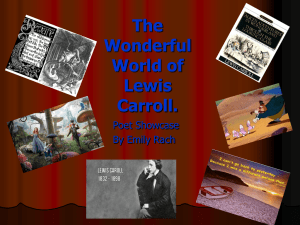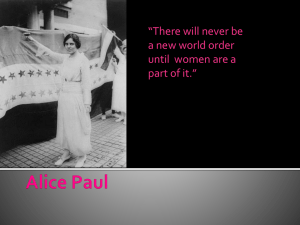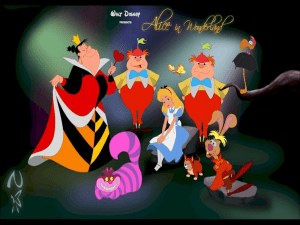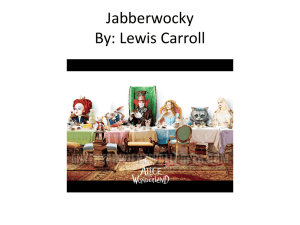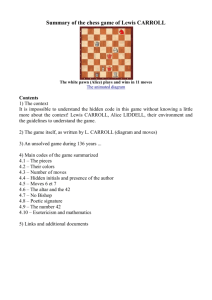Lewis Carroll`s Alice In Wonderland
advertisement
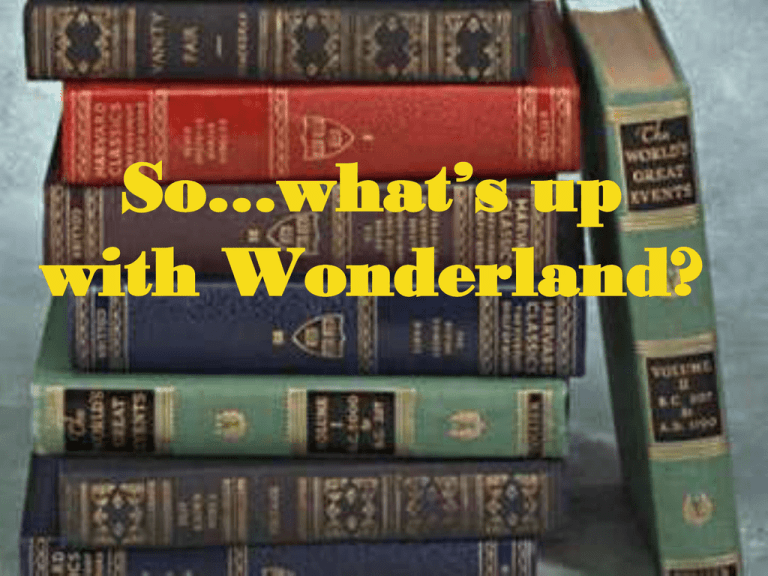
So…what’s up with Wonderland? Lewis Carroll’s Alice In Wonderland “…she came upon a low curtain she had not noticed before, and behind it was a little door about fifteen inches high: she tried the little golden key in the lock, and to her great delight, it fitted!” - Lewis Carroll, Alice in Wonderland Lewis Carroll (1832 – 1898) “Lewis Carroll” is the pen name of Reverend Charles Lutwidge Dodgson, a minister and math professor at Oxford University. A story for Children….or NOT? According to popular accounts, one afternoon in 1862, Dodgson (Lewis Carroll) accompanied the Liddell family on a boat ride. When Alice Liddell asked him for a story, he began one - not just a children’s story, but a tale told on multiple levels. ♠ ♥ ♣♦ ♠ ♦ ♣ ♥ ♠ SATIRE ♠ Approaches serious issues, political problems or social customs ♠ Draws attention to the situation, using humor, irony & exaggeration ♠ Often uses imaginative characters ♠ Verbally caricatures prominent public figures ♠ Appears nonsensical, but has serious undertones Caricature - a visual form of Satire ♣ This is a caricature of Lewis Carroll – exaggerating his most prominent features. ♣ Satire is a verbal form that accomplishes essentially the same effect. ♣ Lewis Carroll was a master of satire. ♠ Nursery Rhymes are another form of satire. “Humpty Dumpty”, for instance, was written about a cannon used during the English Civil War, in the 1600s. When the cannon fell off the wall, neither infantry nor cavalry could repair it. ♠ In “Through the Looking Glass”, Carroll’s sequel to “Alice in Wonderland”, Humpty Dumpty banters about language and labels…representing propriety and class segregation in Victorian society. ♠ Some say this character represents the Oxford Don, a high-ranking University official. Humpty-Dumpty Through an “innocuous” fantasy tale, Carroll satirizes ♦ Insanity ♦ British Empire ♦ Oxford professors ♦ Noted societal figures ♦ Class division & repression ♦ Philosophy & popularly-held beliefs ♦ Victorian customs and etiquette ♦ Aggression and colonization ♦ Public education system ♦ The justice system ♦ Social snobs ♦ Drugs Imperialism During Queen Victoria’s reign, Britain controlled 25% of the world. (areas in pink) ♠ This created unique issues … and superior attitudes… among the British. ♠ Many critics believe that the aggressive characters in “Alice in Wonderland” satirize the aggression of Imperialism and the inequities of the class structure in Victorian Society. ♠ The Mad Hatter Alice The Mock Turtle “I’m late -I’m late!” Caricature of Liddell Possibly another Caricature of Liddell? ♣ Dodgson’s supervisor at Oxford was Dean Henry Liddell, the head of the college of Mathematics. Liddell had a habit of being late for classes and meetings…and hurried everywhere. The white rabbit is probably modeled after him. ♣ Liddell also had three young daughters, whom Dodgson often entertained with stories: Lorina, Edith, and of course…Alice! God Save the Queen ♥ Victoria was a popular queen, but also formidable, eccentric and a bit stuffy. While her shrewdness was politically effective, she was easy to caricature…and some say she was the model for the Red Queen. ♥ Others say the Red Queen is based on the Liddell’s governess. The Caucus Race ♥ The character of the Dodo, an extinct bird, is considered to be Dodgson’s self-deprecating satire of himself, making fun of his own habit of stuttering. Notice that the bird has hands under his wings. ♥ The caucus race was a reference to political party organization (or lack of it) during a primary election. The story includes a “caucus race” where there is a lot of running around in circles and there is no clear winner. ♥ Sound familiar? Social Conventions ♥ Afternoon Tea was a social MUST for upper class British citizens – it was synonymous with “polite society” and “proper civilized behavior.” ♥ Ironically, the snobbery that became associated with tea was anything but polite or civilized. One could say and do perfectly beastly things at tea…as long as one’s manners were intact. ♥ Carroll draws attention to the hypocrisy of tea parties by filling his table with beastly characters who are “quite mad”…including the March Hare and the Mad Hatter. A Mad Tea Party ♠ While fanciful characters and their antics were entertaining to children, they were more entertaining to the adults who recognized them. The Mad Hatter, for instance, was based on a local inventor named Theophilus Carter, who was known for his formal attire and unsuccessful inventions. ♠ Some say the name is a spin on “mad as an adder”, referring to the snake… ♠ It is also believed to be a commentary on hat makers’ use of silver nitrite for stretching the felt used in men’s top hats. The substance contained mercury, and was known to cause blood poisoning and delusional behavior. The Dormouse ♦ Dante Gabriel Rossetti, a PreRaphaelite painter and a good friend of Dodgson’s, had a pet wombat who often slept on his table. “Dormouse” means “dormant” or “sleeping mouse”. ♦ Contrary to popular belief, the Dormouse does not say “feed your head”…as indicated in the Jefferson Starship song, “Go Ask Alice.” ♦ When the dormouse falls asleep at tea, the Mad Hatter & the March Hare stuff him into the teapot. Some say this is a commentary on the repression of the lower classes. Verbal & Visual Wit ♣ Much of the humor in “Alice” is derived from foolish social conventions and customs. The Mock Turtle and the Gryphon “mock” the false appearances and false manners in Victorian Society. ♣ “Mock Turtle Soup” was considered a culinary delicacy, made with calf’s parts. The “Mock Turtle” has a calf’s head and feet. He refers to his former teacher as a tortoise, because, as he says “he taught us”. ♣ Some say the Gryphon and the Mock Turtle represent Dodgson’s two younger brothers. The Game Motif ♣ Games require a set of rules, but Wonderland seems to have none. This is especially frustrating for Alice. ♣ Carroll uses chess, cards, and croquet to show levels of nonsense in society. ♣ Games are often used in literature as a metaphor for trying to learn how the world works. ♣ The queen insists on a game of croquet using flamingoes as mallets and hedgehogs ♣ This is probably a comment on the exploitation of the lower classes for the amusement of the aristocracy The Walrus and the Carpenter ♠“The time has come, the walrus said, to talk of many things…of sails and ships and sealing wax, of cabbages and kings…and why the sea is boiling hot, and whether pigs have wings.” ♠Some critics believe the debate between these two represents Eastern vs. Western philosophies. ♠ Some suggest that the walrus is Buddha and that the carpenter is Jesus.…and that the common people are the oysters, to be converted to one or the other at the convenience of a “superior class”. Opium and altered states ♠ There are several references in “Alice” to mind-altering substances, including: ♠ the “drink me” label on a bottle which makes Alice shrink… ♠ a piece of cake that makes Alice grow huge ♠ a mushroom that also changes her size ♠ a caterpillar who smokes a hookah ♠ and a baby that turns into a pig. ♠ Each of these instances may be indicate the influence of opium, which was legal and commonly used in many households. Its health effects had not been publicized. ♠ Dodgson used laudanum (an opium-based medication) A Little Bill ♣ Benjamin Disraeli was Queen Victoria’s prime minister in the 1860s, the founder of the modern conservative party and a supporter of the Reform Bill. ♣ In the book, the White Rabbit sends in a “bill” during a trial, carried by a lizard character. “Bill the Lizard” is believed to represent Disraeli and his reform bill. ♣ Disraeli was a prominent social and literary figure, and Dodgson (Carroll) admired his wit. ♣ The trial of the Knave of Hearts also satirizes the British court system. “Curioser and Curioser” ♠ The Cheshire cat’s grin is always visible, even when the cat itself disappears. The cat probably represents the falseness of appearances and the insincerity sometimes required in society. ♠ Carroll may have incorporated this character based on a cat face carved on a church, or… ♠ The Cheshire cheese company, who used a cheese maker’s mold resembling a smiling cat. ♠ Alice’s conversations with the cat establish that Wonderland is a place where madness is rampant. Social Theory ♥ Many aristocrats believed that the British, as a superior and dominant society, had the right and the responsibility to treat the “inferior” inhabitants of their conquered territories as if they were children – incapable of taking care of themselves, by Western standards. ♥ When Alice, a child, takes the Duchess’ baby, it turns into a pig...not a child at all. ♥ This may suggest Carroll’s belief that the conquered cultures were quite capable of taking care of themselves, with or without the interference of the Empire. Illustrators ♠ The first edition of “Alice” was published in 1865, with black & white illustrations by political cartoonist John Tenniel. (left) ♠ Later editions included illustrations by Arthur Rackham, a popular illustrator of childrens’ fantasy books of the late Victorian era (right) Britishpoet poetand andliterary literarycritic criticW.H. W.H.Auden British Auden believed that book set out to later suggested that the Carroll’s book shows show the struggle of children the struggle of adolescents to to adjust to an understand adultrules world where rules adult worldan where and established and established order senseless. often made noalso order often seemed He sense. He also implies that Alice is the in implies that Alice is the only character only character inany the self-control book who has the book who has or any follows self-controlher or own follows her own path. conscience. At the♠ end♥ of the book, the♣ White Knight ♣ ♦ ♠ ♦ ♥ ♠ bids farewell to Alice. This may symbolize acknowledgement At the endDodgson’s of the book, the White Knight that hasto grown as may a result of bids Alice farewell Alice.up, This symbolize her experiences. Dodgson’s acknowledgement that Alice has grown up, as a result of her experiences. Great Information Sources for Alice in Wonderland : The Victorian Web http://www.victorianweb.org/authors/carroll/index.html Carroll Forums http://thecarrollforum.proboards46.com The Lewis Carroll Homepage http://www.lewiscarroll.org/carroll.html Lenny’s Alice in Wonderland Site http://www.alice-in-wonderland.net Looking for Lewis Carroll http://www.lewiscarroll.cc
